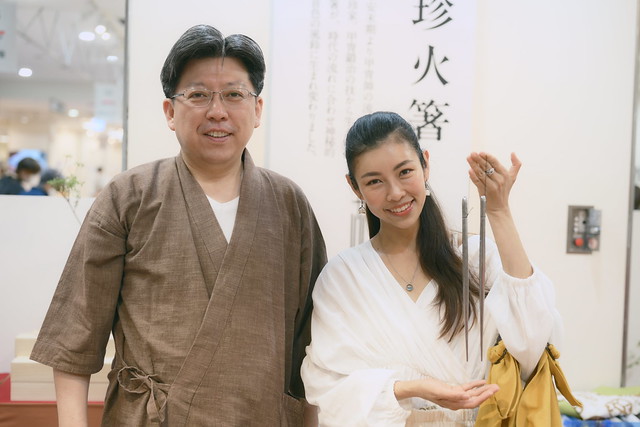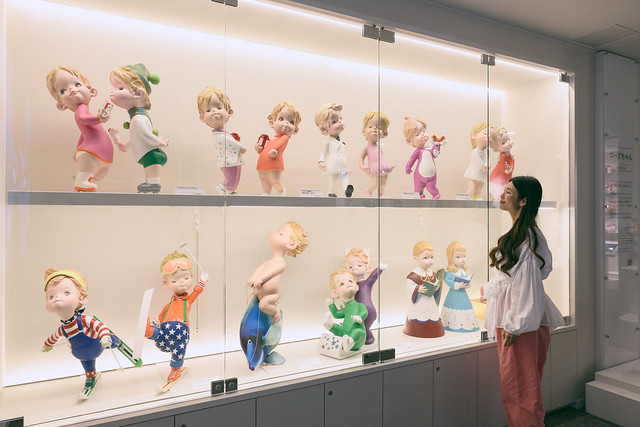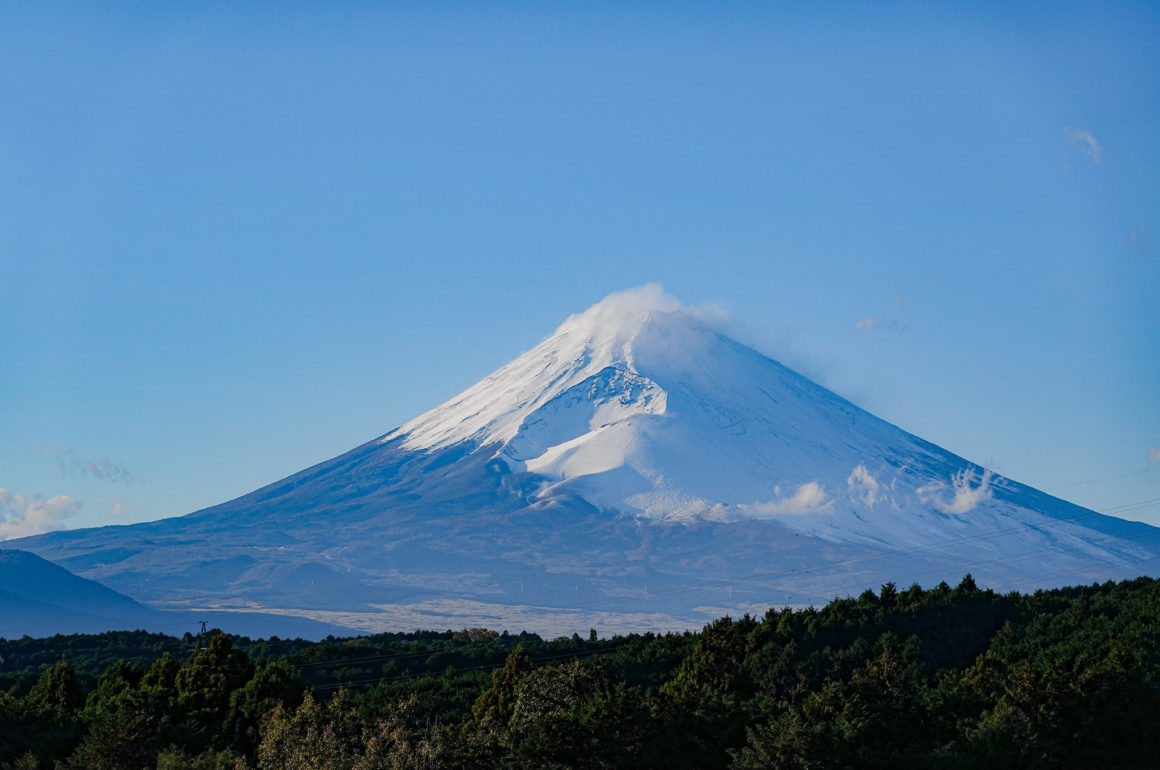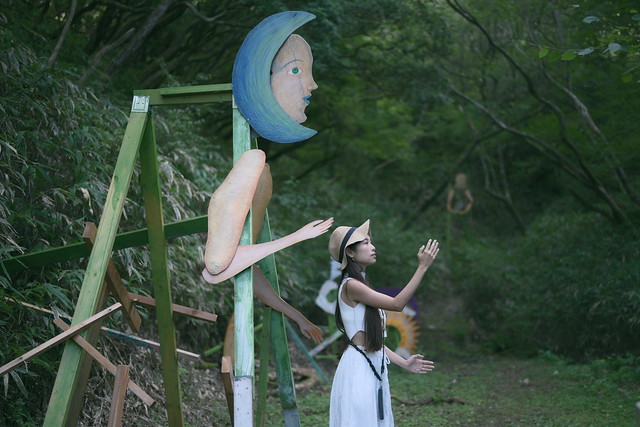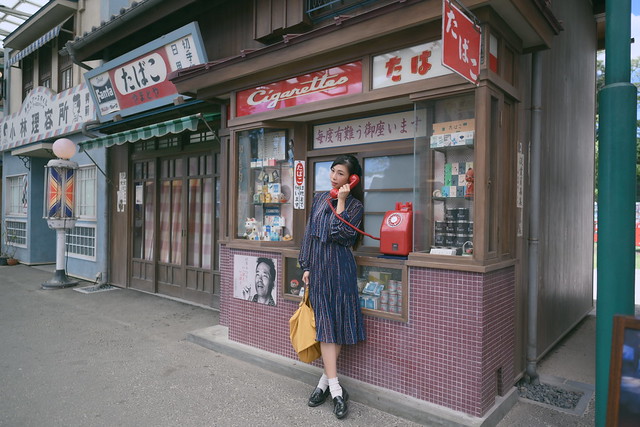Previous Tokai post: MIE PREFECTURE
I hope you enjoyed revisiting Mie prefecture virtually with me. And now, we are venturing into the deep mountains of Gifu prefecture.

Unless you’ve been living under a rock, chances are high that you’ve already heard of the hamlet known as Shirakawago located in Gifu prefecture. Outside of this now well known attraction of though, overseas visitors to Japan often don’t know much else about Gifu (or much else of Central Japan for that matter). Given that there’s a huge array of allures strewn about the prefecture, this is a real shame. From the ever-charming Hida Takayama area to the rustic hot spring town of Gero Onsen, you’re spoiled for choice in Gifu.
For those not already in the know, understand that Gifu is a prefecture that is sandwiched between the bookends of Tokyo and Kyoto. Located north of the city of Nagoya, Gifu has long been an important strategic holding for Japanese leaders. The famous Nakasendo trade route runs right through the south of the modern-day, landlocked prefecture. This highway was a vital artery that connected eastern Japan with the former capital of Kyoto. Because of this, many castle towns popped up over the centuries to watch over this crucial portion of the country.
Given its location, Gifu combines well with any trip to either Central Japan or to Kyoto. You can tack on a visit to any one of Gifu’s seven neighboring prefectures and famous attractions such as world heritage Gokayama (Toyama prefectue), Matsumoto Castle (Nagano prefecture) and more, or make a detour up from Nagoya when en route to Kyoto. Either as a day trip or as a multi-day excursion, Gifu is able to integrate itself into just about any itinerary. In the below paragraphs, I’ll introduce some of the spots that I personally enjoyed during my recent stint in Gifu.
Access:
I ended my trip at Nabana No Sato, Kuwana of Mie prefecture, took a 45-minute bus ride to transit at Nagoya Station, and then hop on the train bound for Gifu. It’s an unexpectedly short trip, to my surprise – it took less than half an hour to get from Nagoya Station to Gifu Station.
Since it was pretty late, I stayed a night near Gifu Station to recharge for the next adventure.
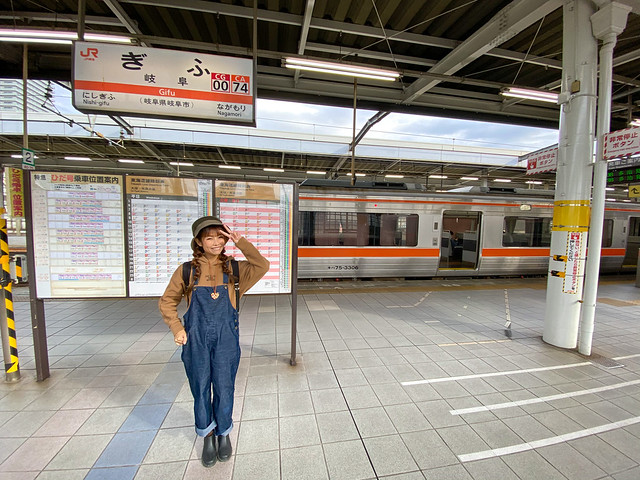
The next morning, I took the limited express Wide View Hida, a scenic train that runs from Gifu Station all the way to Toyama Station. In between you will pass by many of the famous destinations in Gifu – Gero Station, Takayama Station and we will get down at Hida-Furukawa Station.
DAY 1
Hida-Furukawa (飛騨古川)
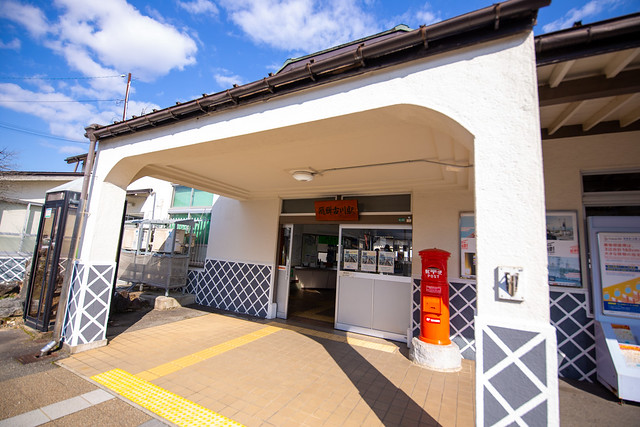
Hida-Furukawa Station
Hida-Furukawa, a somewhat quieter town compared to the nearby and better known Hida-Takayama which is shot to fame by world popular anime “Your Name” in the past years, is a equally charming old town tucked deep in the mountains of northern Gifu, almost bordering Toyama prefecture.

Retro looking building at one of the main streets

Surrounded by pristine mountains all around, autumn season is no doubt a very wise choice for sightseeing in Hida-Furukawa.

Soba (buckwheat noodle) is a specialty in this area, (you can actually witness buckwheat fields when you take a cycling tour around town!) you absolutely do not want to miss out Fukuzenji Soba, which serves ultra delicious “new soba”, namely buckwheat that’s freshly harvested in autumn. If you are a fan of negi (leek), please order the “egoma negi” as a side dish to go with.
Setogawa River and Koi Fish
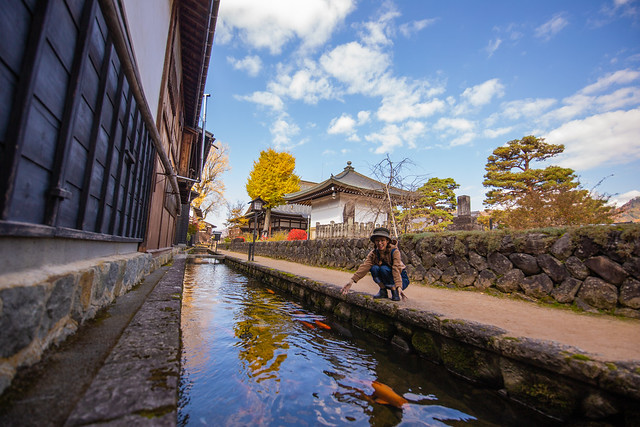
Many travelers came here to admire the living marvels of beautiful, strong koi fishes wading elegantly through the “canal”, which looks more like a drain in our southeast asian definition. I call it the longkang fish.

Decades ago, the residents here used to do their daily chores here at Setogawa canal, including retrieving drinking water, washing vegetables and doing laundry.
But why the fish now?
The story behind why a thousand colorful koi are present in this crystal clear stream that runs along the streets of Hida-Furukawa was quite a moving one for me. As Japan’s economy flourished post-war, Setogawa canal has slowly turned impure and filthy along with industrialization in the area… As clean and fresh water is a Hida pride, the local people thought of ways to restore it back to its pristine state before, and one of the ideas was to bring new residents to the canal – koi fish, so that people will come to admire the canal instead of chucking trash into it.
As clean and fresh water is a Hida pride, the local people thought of ways to restore it back to its pristine state before, and one of the ideas was to bring new residents to the canal – koi fish, so that people will come to admire the canal instead of chucking trash into it.
Maintaining this surreal, gorgeous view isn’t an easy feat, though. As Hida-Furukawa gets heavy snowfall each year, the canal will be too cold for the koi fishes, so by the end of November, a massive effort is made to move these beautiful but really heavy carps to a pond where they could get through the winter healthily.
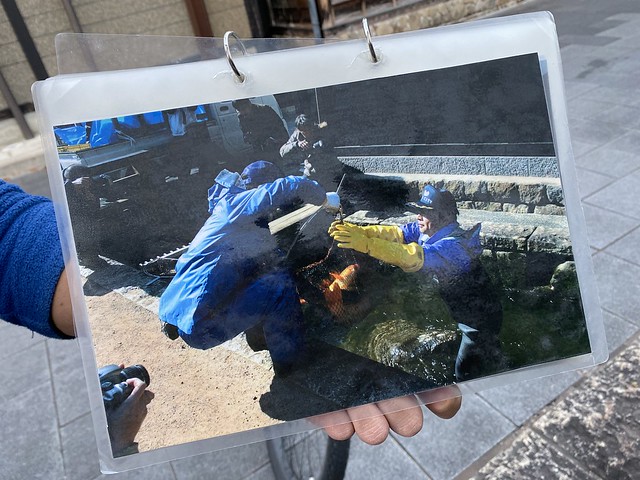
So if you want to meet these gorgeous fish, come between spring and autumn!,
Cycling with Satoyama Experience
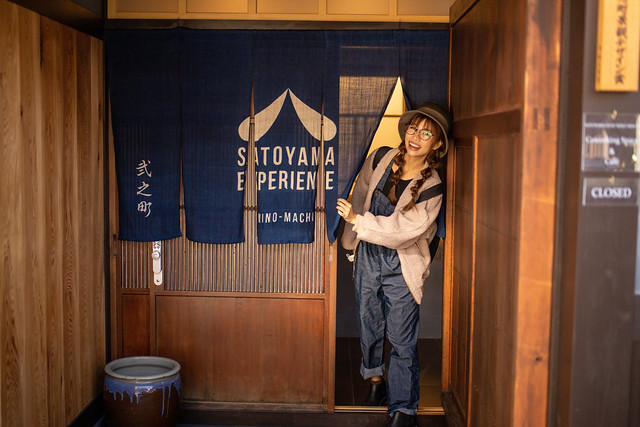
Satoyama Experience actual run a really quaint small guesthouse (right at this building), and also offers a second-to-none cycling experience in the region. The course that I signed up is 2 hours, apparently there are even longer ones, if you fancy a really slow-paced, thorough exploration of the town.

My cycling guide, Yoshi.
If a two whole hour of pedaling scares you, don’t worry. As Hida-Furukawa is practically a basin, most of the path are flat. Even for a fitness noob like me, the 2 hour was a breeze.
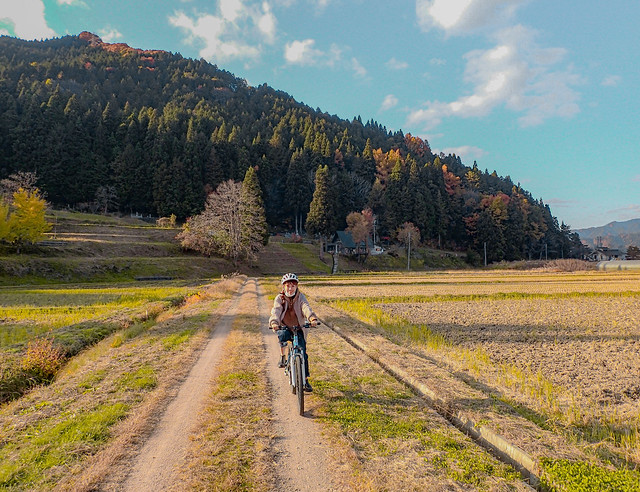
The center of Hida-Furukawa is compact enough to be explored on foot. However if you want to see rice fields, traditional farmhouses, cycling is no doubt one of the best ways to enjoy a rural village and learn about the daily life up-close.
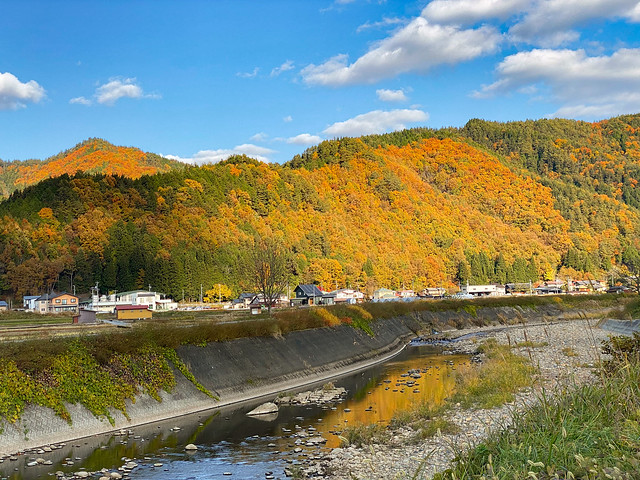
Here’s the mountains of Hida-Furukawa dressed in a palette of autumn.
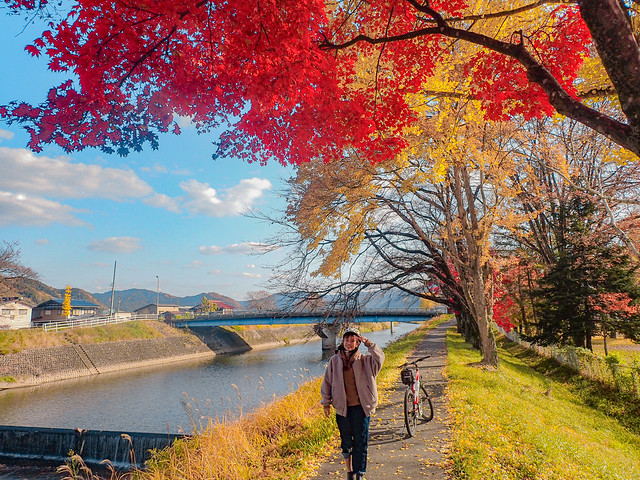
How scenic is this place?

I also spotted a 1200-year-old gingko tree, standing in all its golden glory in the middle of the farm side.
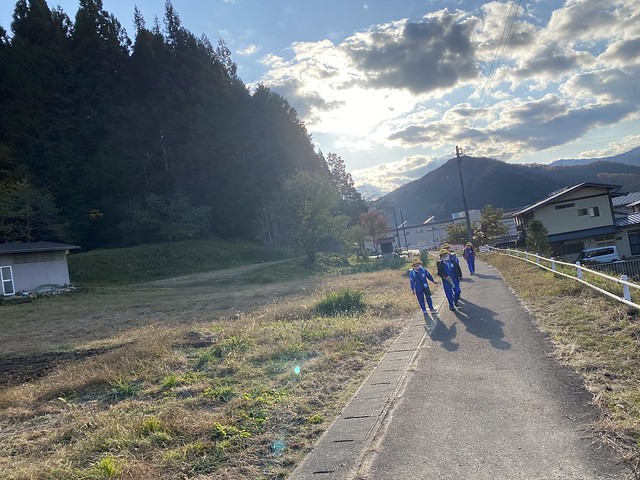
Passing a herd of curious tiny school children (of maybe 6, 7 years old?) walking home after school, a sight to be seen possibly only in Japan.
“Your Name” (Kimi no Na wa)
If you are a fan of the Shinkai Makoto’s anime “Your Name”, you gotta make a pilgrimage to the real life village that is known to be the model of the fictional town “Itomori” in the ultra popular movie.
Here are some of my attempts to re-enact some of the scenes in Your Name:
Hida-Furukawa Station

This is the station where Taki first arrived at “Itomori Town”.
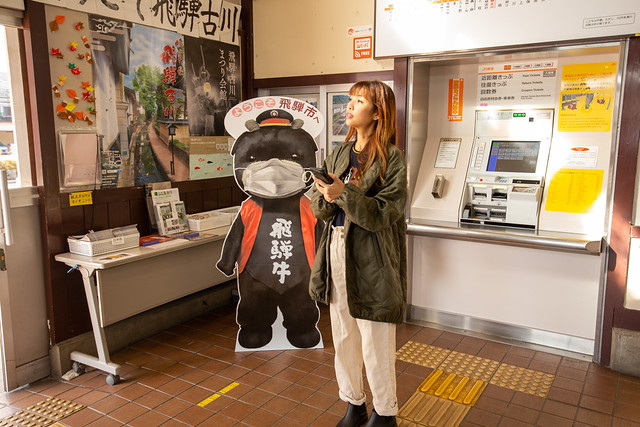
Furukawa’s mascot – Hida-gyu spotted.
Ajidokoro Furukawa
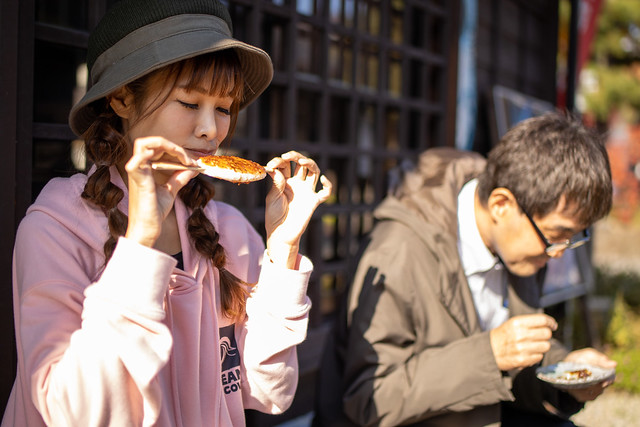
A restaurant, where Taki’s senpai, Miki and his best friend Tsukasa were eating the popular local delicacy “Gohei Mochi”.
There are many Your Name related spots in Hida-Furukawa and Takayama area. Have fun checking them out! You can refer to me IG post below for more details.
View this post on Instagram
Photo credit: ©2016「君の名は。」製作委員会
Yatsusankan 八ツ三館
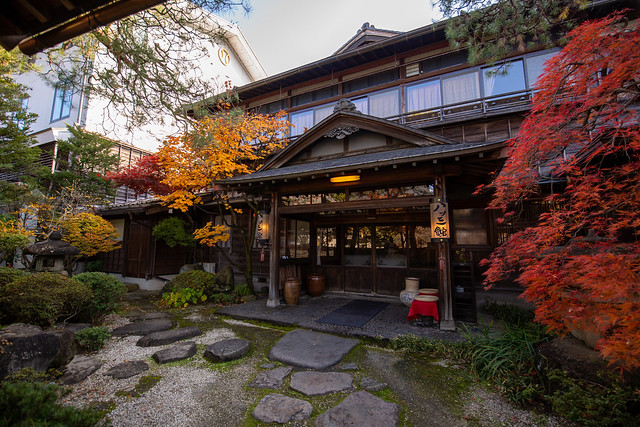
Yatsusan-kan is a century-old ryokan with over 160 years of history. One of its splendid wooden halls that’s rebuilt about 100 years ago is proudly registered as “Tangible Cultural Property of Japan” .

Its bizarre blend of luxurious and rustic vibe is astonishing… For example you will find jazz music playing in an Edo-inspired lounge overlooking a Japanese garden.
The okami-san and her staff’s attention to every last detail is impressive to say the least. Although partly renovated, note that most of its structure still remains from what is left a century ago so do expect really basic amenity in your room and nothing too fancy.


The highlight however, is the cuisine served here. It almost makes sense to say that one come all the way here for the food. The kaiseki style dinner for me was marvelous to say the least. Michelin standard, in fact. Same goes for breakfast.
Such an amazing culinary experience comes with a pretty price tag, expectedly, but it’s worth a night stay if you are looking for some authentic Japanese hospitality in the area of Hida-Furukawa.
Gujo Hachiman (郡上八幡)
Next stop on my list was Gujo Hachiman, a true hidden gem of Gifu in my opinion. To get to Gujo Hachiman, first you transit at Takayama Station, get on an express bus and get down at Gujo Hachiman Inter. The journey will take about 1.5 hours, and once you alight it’s another quick taxi ride into the town center. From then on you can explore everything on foot.

Tucked in the middle of Gifu prefecture, this super hidden treasure is also lovingly called the “Water City”. We will find out why in just a while.

This is Sogi Spring, a symbol of Gujo Hachiman. It is the first spring to be selected as one of Japan’s “100 Best Waters”.
This area is a communal watering spot using the “Mizu Fune” system. Mizu Fune, or “water boat”, is unique to Gujo Hachiman and is an ecologically friendly system of tiered wooden or stone basins, where water flows down from the top basin into lower ones. Water from the topmost basin has the purest source of water and therefore is suitable for drinking. The lower basins are reserved for cooling or washing fresh vegetables, or in some cases even rinsing laundry.
With this efficient use of precious source of nature, the townspeople were able to keep water running through the town exceptionally clean for centuries, and Sogi Spring serves as a testament to and celebration of the area’s pure waters.
With these brilliantly clear water as a result of the entire town and its people’s cooperation and immense respect for nature’s source, it is no wonder Gujo Hachiman is home to the best ayu (sweetfish) in Japan!

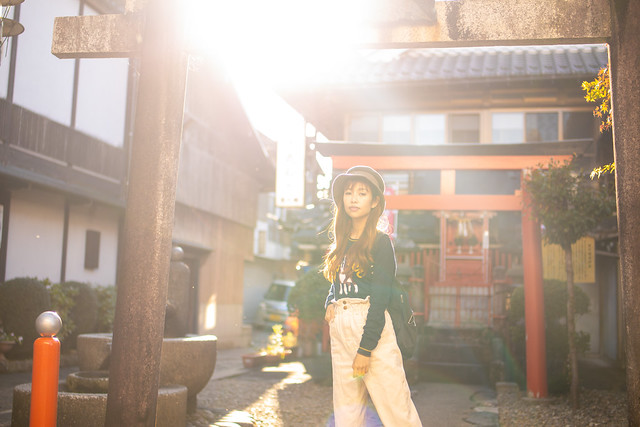
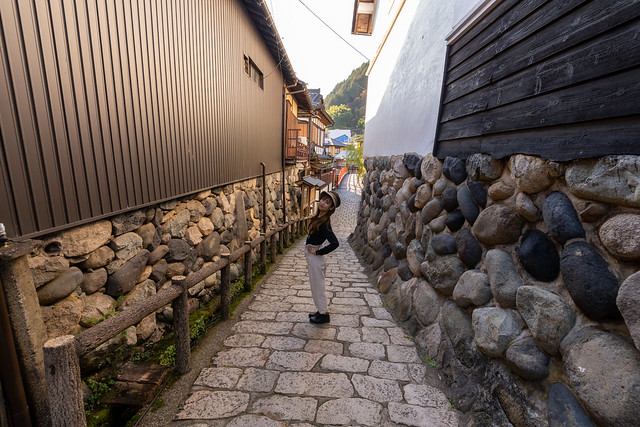
The entire town, so well removed from the bustle of neighboring cities that it retains the distinct flavor of flourishing past back in the Edo period is just the right place one needs for bonafide traditional Japanese experience.
Gujo Odori
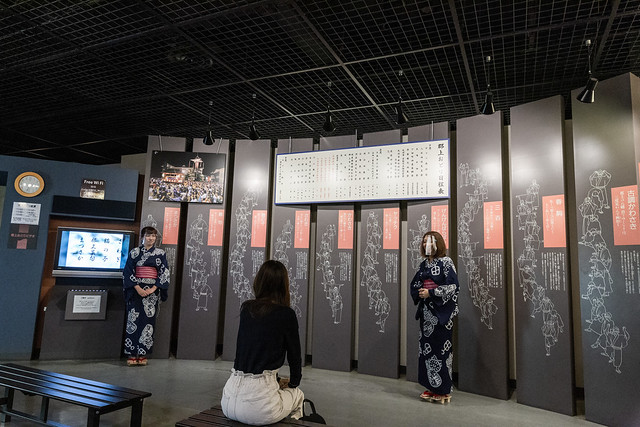
You probably know Bon Odori, a traditional dance carried out in the summer seasons. Gujo Odori is one of Japan’s Three Great Dance Festivals, it is also the longest of them all, held around a period of 30 over nights, including a 4-day “tetsuya-odori” – literally “all-night dance”, where the happy locals frolic in their yukata till the wee hours of the morning!
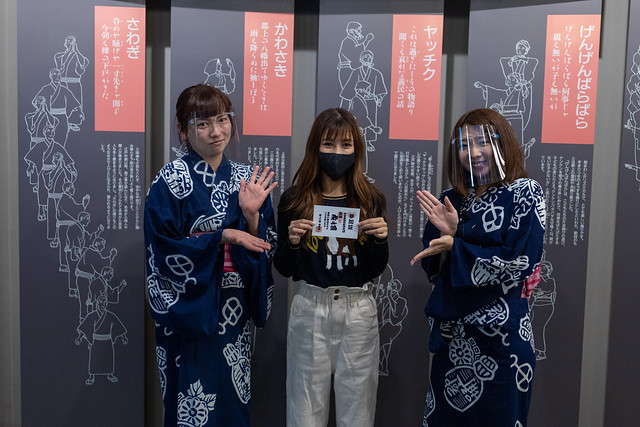
At Gujo Hachiman museum, you get to learn all about this unique festival and even try a couple of elegant moves yourself.
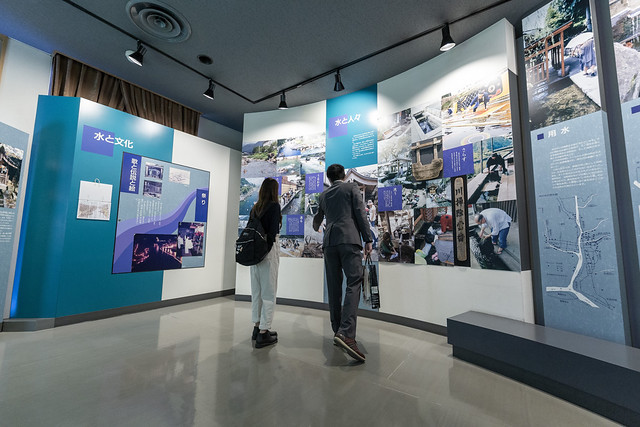
The second floor houses an array of exhibition depicting local lifestyle, history and culture.
Sample Kobo – Food Replica Workshop

Housed in a 150-year-old building, this food replica shop is one of the reasons young travelers visit this charming town.
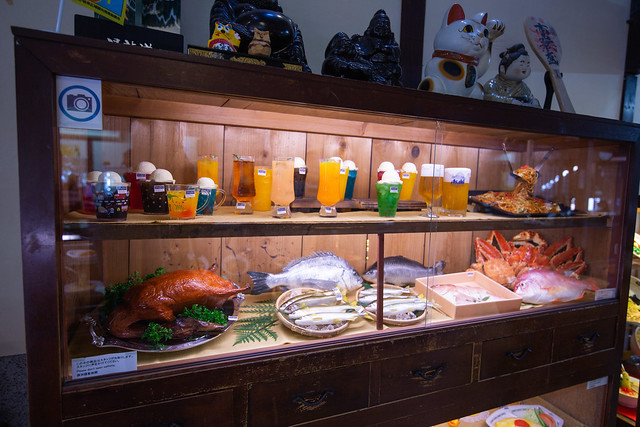
Did you know that these incredibly realistically yummy plastic food you see adorning the windows of many of Japan’s restaurant were actually born right here in Gujo Hachiman?
The father of food replicas, Iwasaki Takizo was inspired as a child by a droplet of candle wax turning into the shape of a beautiful flower, and that’s how the idea of now omnipresent food replicas all over the world is first conceived.

Of course, as a pride of Gujo Hachiman, you can find lots of faithfully replicated food samples here, and even try making a piece yourself!
Gifu City
The final destination of this installation of Gifu is its capital city of the same name.
Even if you are completely uninterested in Japan history, when you come to Gifu, you just need to remember one historical name: Oda Nobunaga, or just Nobunaga, as the Japanese people lovingly refer this great feudal warlord as, who serves as the first great unifier of Japan that you see today (he was so, so close to put all of Japan under his power!).
Gifu Castle

Gifu Castle looms over the city atop Mt Kinka. Although not as famous worldwide as other castle such as Himeji or Matsumoto, Gifu Castle has recently been showered lots of attention within the country as Japan’s hottest historical drama of 2020 features the stories of samurai of the warring states that are closely related to this region.
During the Warring States period, the castle came under the control of the great Oda Nobunaga, who deemed the area as best suited as the base for his quest to unify all of Japan. At the crossroad of east and west Japan, Mino (Gifu’s old province name) was a junction so strategic militarily and economically that it was said that “those who control Mino control all the lands under the heaven”. In fact, it was Nobunaga who changed the name of the area, from “Inokuchi” to “Gifu”.
Until today, the citizens of Gifu continue to honor this great unifier of Japan through cultural celebrations such as Gifu Nobunaga Festival to keep his contributions very much alive in the local lands.
You can access the castle by either taking a 3-minute ropeway (autumn view is a gourgeous bonus!) or hike you way up.
Squirrel Village

Take a rest from the heaviness of historical characters and get some fluffy love at the squirrel village within the Gifu Park which is just minute’s walk away from Gifu Castle. Entrance fee is JPY200 and you get to feed these adorable Taiwanese squirrels.
The Great Buddha of Gifu
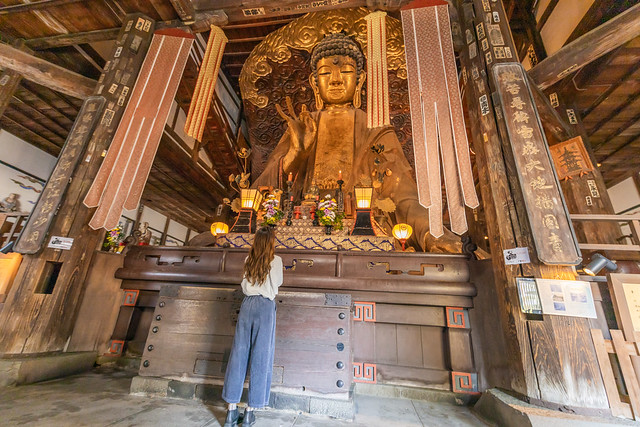
Listed as one of Japan’s Three Great Buddha Statues along with the ones at Todaiji, Nara prefecture and Kotokuji, Kamakura, the Great Buddha of Gifu is a great add-on to your visit to Gifu Castle.
Located just a short walk away, one marvels at one of the biggest Buddha statues in Japan, unconventionally made of a wooden and bamboo frame which was then covered in clay with Buddhist scriptures. Next, lacquer was applied over and over again and finally it was enhanced with gold leaf, giving its opulent appearance.
That’s all for Gifu Prefecture this time. Next I will be exploring one of traveler’s favorite hub of Japan – Nagoya.
Stay with me for more content!
Meanwhile, check out JAPAN by Japan for travel ideas, itinerary and a chance to win a pair of return flight tickets to Japan!


